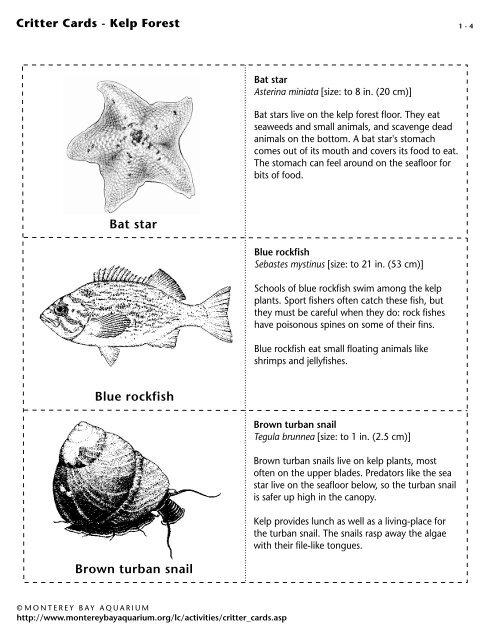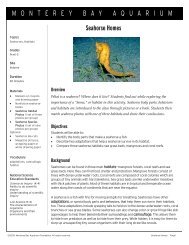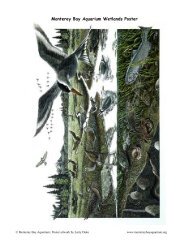You also want an ePaper? Increase the reach of your titles
YUMPU automatically turns print PDFs into web optimized ePapers that Google loves.
Critter Cards - <strong>Kelp</strong> <strong>Forest</strong><br />
Bat star<br />
Blue rockfish<br />
Brown turban snail<br />
© MONTEREY BAY AQUARIUM<br />
http://www.montereybayaquarium.org/lc/activities/critter_cards.asp<br />
Bat star<br />
Asterina miniata [size: to 8 in. (20 cm)]<br />
Bat stars live on the kelp forest floor. They eat<br />
seaweeds and small animals, and scavenge dead<br />
animals on the bottom. A bat star's stomach<br />
comes out of its mouth and covers its food to eat.<br />
The stomach can feel around on the seafloor for<br />
bits of food.<br />
Blue rockfish<br />
Sebastes mystinus [size: to 21 in. (53 cm)]<br />
Schools of blue rockfish swim among the kelp<br />
plants. Sport fishers often catch these fish, but<br />
they must be careful when they do: rock fishes<br />
have poisonous spines on some of their fins.<br />
Blue rockfish eat small floating animals like<br />
shrimps and jellyfishes.<br />
Brown turban snail<br />
Tegula brunnea [size: to 1 in. (2.5 cm)]<br />
Brown turban snails live on kelp plants, most<br />
often on the upper blades. Predators like the sea<br />
star live on the seafloor below, so the turban snail<br />
is safer up high in the canopy.<br />
<strong>Kelp</strong> provides lunch as well as a living-place for<br />
the turban snail. The snails rasp away the algae<br />
with their file-like tongues.<br />
1 - 4
Critter Cards - <strong>Kelp</strong> <strong>Forest</strong><br />
Cabezon<br />
California sheephead<br />
Decorator crab<br />
© MONTEREY BAY AQUARIUM<br />
http://www.montereybayaquarium.org/lc/activities/critter_cards.asp<br />
Cabezon<br />
Scorpaenichthys marmoratus<br />
[size: to 3.25 ft. (99 cm)]<br />
Like their relatives, the small tidepool sculpins,<br />
cabezons live on the bottom in rocky areas.<br />
When they sit still, their waving fins and mottled<br />
color blend in with the surrounding seaweed.<br />
Cabezons eat invertebrates like crabs and snails,<br />
and some fishes. They swallow abalones whole,<br />
then spit out the shells. "Cabezon" means<br />
"big head" in Spanish. This fish has a big mouth,<br />
too—it can gulp large prey.<br />
California sheephead<br />
Semicossyphus pulcher [size: to 3 ft. (91 cm)]<br />
Sheephead swim above rocky areas. These fish<br />
are all born female, but turn into males when<br />
they grow to about 12 inches. They also turn<br />
color, from red to red-and-black with white chins.<br />
Sheephead eat snails, crabs, urchins and other<br />
shellfish. They're good to eat, so divers often<br />
catch them.<br />
Decorator crab<br />
Loxorhynchvs crispatus [size: to 3.5 in. (8.8 cm)]<br />
A decorator crab camouflages its shell with algae,<br />
sponges and other things that grow on local<br />
rocks. When the crab sheds the shell for a new<br />
one, it has to redecorate. Often, the crab will<br />
transfer material from the old shell to the new.<br />
Decorator crabs eat algae, sea urchins, small<br />
crustaceans and sponges.<br />
2 - 4
Critter Cards - <strong>Kelp</strong> <strong>Forest</strong> 3 - 4<br />
Fish-eating anemone<br />
Gumbot chiton<br />
Red abalone<br />
© MONTEREY BAY AQUARIUM<br />
http://www.montereybayaquarium.org/lc/activities/critter_cards.asp<br />
Fish-eating anemone<br />
Urticina piscivora [size: to 8 in. (20 cm)]<br />
This anemone snares shrimp and small fishes. Its<br />
stinging tentacles shoot thousands of tiny<br />
harpoons into the prey to hold it. A poison from<br />
the harpoons stuns the prey. After making a<br />
catch, the anemone stuffs the meal into its<br />
mouth then closes up to digest it.<br />
Gumboot chiton<br />
Cryptochiton stelleri [size: to 12 in. (30 cm)]<br />
The gumboot chiton is the largest chiton in the<br />
world. It lives on the kelp forest floor, clinging to<br />
rocks with its single large foot. It looks like half a<br />
football, but is related to snails and clams. Its<br />
eight shells are inside, like a skeleton.<br />
A gumboot chiton eats mostly red seaweeds,<br />
rasping with its filelike tongue.<br />
Red abalone<br />
Haliotis rufescens [size: to 11.8 in. (30 cm)]<br />
Red abalone live in crevices, rarely moving far<br />
from a chosen spot on the rock. The holes in the<br />
shell are outlets for water circulation.<br />
These abalone catch passing seaweed for food.<br />
When the tentacles sense a large piece of drifting<br />
kelp, the abalone rears toward it, then grabs the<br />
seaweed with its big foot.
Critter Cards - <strong>Kelp</strong> <strong>Forest</strong><br />
Spiny brittle star<br />
Sea otter<br />
Sea cucumber<br />
© MONTEREY BAY AQUARIUM<br />
http://www.montereybayaquarium.org/lc/activities/critter_cards.asp<br />
Spiny brittle star<br />
Ophiothrix spiculata [size: to 5.7 in. (14.4 cm]<br />
Brittle stars hide among rocks and in the rootlike<br />
kelp holdfasts, anchored into cracks by their long<br />
spines. Their delicate arms break easily, but also<br />
grow back quickly.<br />
Brittle stars catch suspended food particles by<br />
waving their arms through the water. Small tube<br />
feet on each arm transfer the food to the mouth.<br />
Sea otter<br />
Enhydra lutris [size: to 5.5 ft. (1.7 m)]<br />
For warmth, the sea otter relies on its thick fur<br />
coat with 600,000 hairs per square inch. The otter<br />
spends nearly half its waking hours grooming its<br />
fur coat to keep it waterproof.<br />
The otter dives for shellfish, then eats lying on its<br />
back at the surface. Because it consumes abalones<br />
and crabs, the otter sometimes competes with<br />
people for food.<br />
Sea cucumber<br />
Parastichopus californicus [size: to 16 in. (40 cm)]<br />
Sea cucumbers creep slowly across the kelp forest<br />
floor. Relatives of the sea stars, they use hundreds<br />
of tiny suction cup feet called "tube feet" to move.<br />
The tentacles around a sea cucumber's mouth are<br />
also a type of tube foot. The sea cucumber<br />
brushes the tentacles across the seafloor as it<br />
moves, collecting organic particles and stuffing<br />
them into its mouth.<br />
4 - 4












